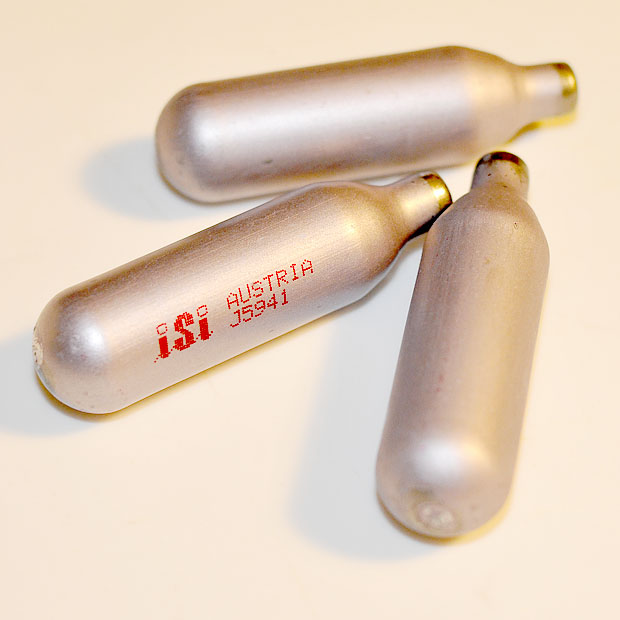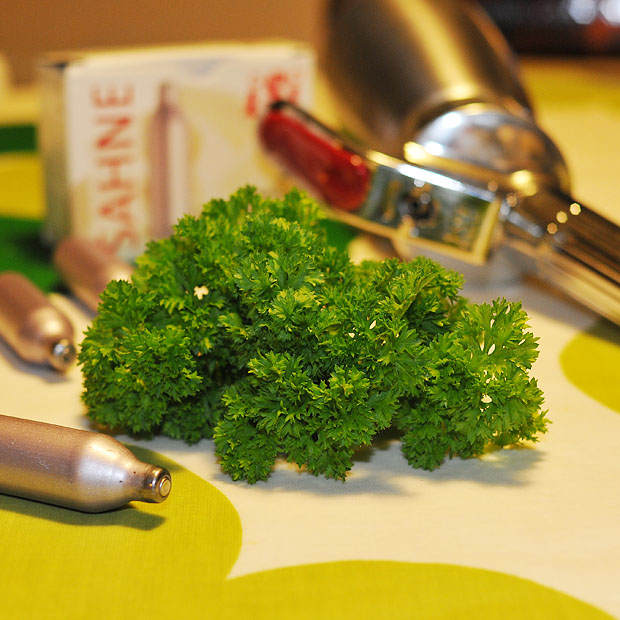
Cream chargers containing 8 g of nitrous oxide each (N2O) to be used with an iSi whipper for whipping cream, making foams/espumas or pressurized infusions.
A little more than a week ago Dave Arnold posted a great, new technique: pressure infusion using a conventional iSi whipper! Just think of it – the whipper has been around for decades, and years a go Ferran Adrií pioneered it’s use for espumas. Several have suggested it’s use for carbonation of fruit. But no one had thought of utilizing the whipper for infusions – until August 11th when Dave Arnold of Cooking issues posted the results of his experiments in “Infusion Profusion: Game-Changing Fast “˜N Cheap Technique”. The first blogger to pick up the technique and post about it on August 12th was Linda of playing with fire and water who termed it a revolutionary technique. A couple of days later, on August 17th Aki and Alex of Ideas in food posted a combined pressurized infusion of basil and marination of mozzarella. And then on August 20th James of Jim Seven describes his results comparing conventional cold brewed coffee to cold pressure brewed coffee. It’s really fascinating how fast the idea spread, and it illustrates the benefits of an open and sharing approach to food innovations.
The science behind this is quite simple: in the pressurized canister nitrous oxide (N2O) dissolves and penetrates the food. When the pressures is suddently released (and it is important to release pressure as fast as possible) the sudden pressure drop causes the dissolved gas to nucleate and form bubbles which expand and disrupt cells, thereby releasing flavor compounds. The physical phenomenon is known as cavitation.
A single N2O charger contains 8 g of gas corresponding to 0.1818 moles or a volume of 4.1 L at 25 °C and 1 atm pressure. The volume of the chargers is 0.01 L which gives an impressive initial pressure in the chargers of 445 atm! With an approximate volume of 0.7 L the pressure in an empty whipper charged with a single charge would be nearly 6 atm. When liquids are added the volume decreases, but the effect on the head pressure will depend on the type of liquid added. The solubility of N2O in water is 0.15 g/100 mL at 15 °C, meaning that with 100 mL of water, the head pressure would be roughly 10% higher than in an empty canister (that is, if the solubility is independent of pressure – I’m not quite sure about this). However, since N2O is a rather non-polar molecule the solubility in ethanol or even oils is much greater than in water, with a resulting lower head pressure. But since flavor delivery is mediated by the dissolved gas suddenly nucleating and bursting cell structures, infusions using ethanol or oil will actually be more effective than those with water because more gas can be dissolved in these solvents (besides the fact that ethanol and oil are better solvents for flavors than water).

Thinking about how I could utilize the pressure infusion technique I came to think about the problems I ran into with hay like off flavors in the parsley and banana flavored marshmallows I made for TGRWT #2. The off flavors can be traced back to 3-methyl-2,4-nonanedione which likely stems from oxidation of unsaturated fatty acids or polyenes. Crushing parsley inevitably leads to oxidation (possibly also enhanced by mixing intra and extra cellular comounds/enzymes), but with pressure infusion – practically in the absence of air – seems to be much gentler than crushing according to Dave’s initial report (as judged by color). So I did a quick experiment with this, infusing a couple of sprigs in 2 dL of water for about 2 minutes. This was by no means enough, and the water had only a faint aroma of parsley (vodka would of course have been much better for the flavor extraction). But it was a clean parsley aroma, and the water was perfectly clear.

It is a great technique. I wonder what traditional infusions would benefit from the speed of this method. Limoncello would be worth a try.
As a Chef who uses a tumbler to marinate meats, where the vacuum opens the pores to allow the infusion of the marinate. How does putting pressure into a vessel achieve the same effect.
Can some one explain.
Thanks
> that is, if the solubility is independent of pressure – I’m not quite sure about this
I’m no physicist, but since you can degas water by putting it into a vacuum pump, doesn’t it mean that solubility does depend on the pressure?
Matthieu: On second thought – yes! I’m quite sure that the solubility of N2O will increase with pressure.
[…] on Friday about quick infusion of spirits in a whipped cream siphon, I came across Martin’s excellent post on the subject on his blog, Khymos. I encourage everyone to read it, if you haven’t […]
Good to read more about the science behind this.
I didn’t know that “it is important to release pressure as fast as possible”- my instincts told me otherwise. I tried it with roses (my own and my neighbors) and water. I also get a very clean aroma – but nothing strong enough. On to Alcohol and oils then..
Fantastic article, thank you!
The critical temperature and pressure for N2O is 36.6 deg C and 73.4 atm, respectively. Hence, inside these chargers the gas will indeed not be a gas, but most likely a liquid (below ca. 37 degrees C) or a supercritical fluid (above ca. 37 degrees C).
Not that this makes a big difference for the cooking, because the N2O will evaporate to become a gas as soon as it is discharged into the siphon. My point, however, is that the pressure in the charger might in fact not be 445 atm at all because one cannot expect it to adhere to the laws meant for ideal gases (I guess you used the ideal gas law for estimating the pressure). What we can agree about, though, is that this is quite impressive anyhow whatever pressure they manage to pump into these small things 🙂
Carlton: When the pressure is released, the escaping gas opens up the cells, releasing the contents to the solution. Both pressure infusion and vacuum tumbling it’s the (sudden) change in pressure that opens up cells and pores respectively.
Erik: You’re right! It never occured to me to check the triple point. Have you been able to find a phase diagram for N2O?
No, I wasn’t able to find any open access easily laid out phase diagram as you’d find for CO2 (which is the most common compound/solvent/gas used in liquid or supercritical state such as caffeine extraction). This web page has some relevant curves and info that might be used to extract some information.
A full phase diagram can be found at Ferreira et al. (2009). Nitrous oxide: Saturation properties and the phase diagram. The Journal of Chemical Thermodynamics, 41(12), 1394. http://dx.doi.org/10.1016/j.jct.2009.06.017
The fact that it’s published as late as 2009 is quite surprising, really. Especially since N2O is being used as an anaesthetic, in food etc.
Maybe I’ll write a post on supercritical fluids in food production? That’d been fun (for me, at least…)
[…] Wonders of extraction: Pressure By tnrplaya Leave a Comment Categories: Uncategorized Wonders of extraction: Pressure. […]
The solubility product is constant at a given temperature.
However, changing the pressure causes the dissolved quantity to change, as the position of the equilibrium changes. High pressure means more gas dissolved, and vice versa.
i saw this on cooking issues. I love how the sharing of ideas helps develop techniques. things keep getting better and better. thx for sharing 🙂
Hi,
If we want to approach to this scientifically we need controls!
I’d decompose the process in three steps: release of flavor compounds, solution of them into the liquid and “storage” of dissolved compounds.
Flavor compounds in plants are very superficially so, we dont need to break the cells to extract them. Maybe that helps and does it faster but some other compounds will release together. If so, freeze/thawn process would make same effect.
In this step, pressure doesnt affect.
Disolution is depending of polarity of solvent/compounds according to partition coeficient.
Ethanol make water less polar so it helps to dissolve aromatic compounds (they are partially non-polar)
N2O is non-polar too and since it dissolves in water proportionally to presure,according to Henry´s law, it’d help to dissolve more compounds
I think this is the key factor.
Our control is only water (instead of liquor) and other gas like N2, even more non-polar than N2O or even comprissed air (70% N2).
This step is also affected by pressure so what about 2 charges instead of only 1.
The “storage” of aromatic cmpounds is definitively affected by pressure according to Henry´s law again (considering to the volatile compounds are partially gases), but it just affects for few second until the pressure is releases from whipper (maybe few second later too), but never for minutes.
So we’d need to compare frozen-thawn vs fresh, water vs liquor and N2 vs N2O and 1 charge vs 2 charges to consider any conclusion.
Any volunteer to do it?
🙂
Very interesting and not a million miles away form supercritical fluid extraction. I would be nice to try pure SCF extraction with foods so that a second solvent wouldn’t be required. A more accessible SCF is butane which has been used successfully to extract hydrocarbon soluble plant oils very effectively, albeit a bit dangerously.
If the infusion is primarily caused by the cavitation effect on releasing the pressure, surely the amount of time that the flavours are left to infuse for prior to venting should be irrelevant? Why infuse for two minutes?
[…] I need to get myself a whip cream container, this looks awesome. Wonders of extraction: Pressure […]
[…] en Khymos, explica por encima en qué consiste en proceso (por cierto, que en los comentarios se profundiza […]